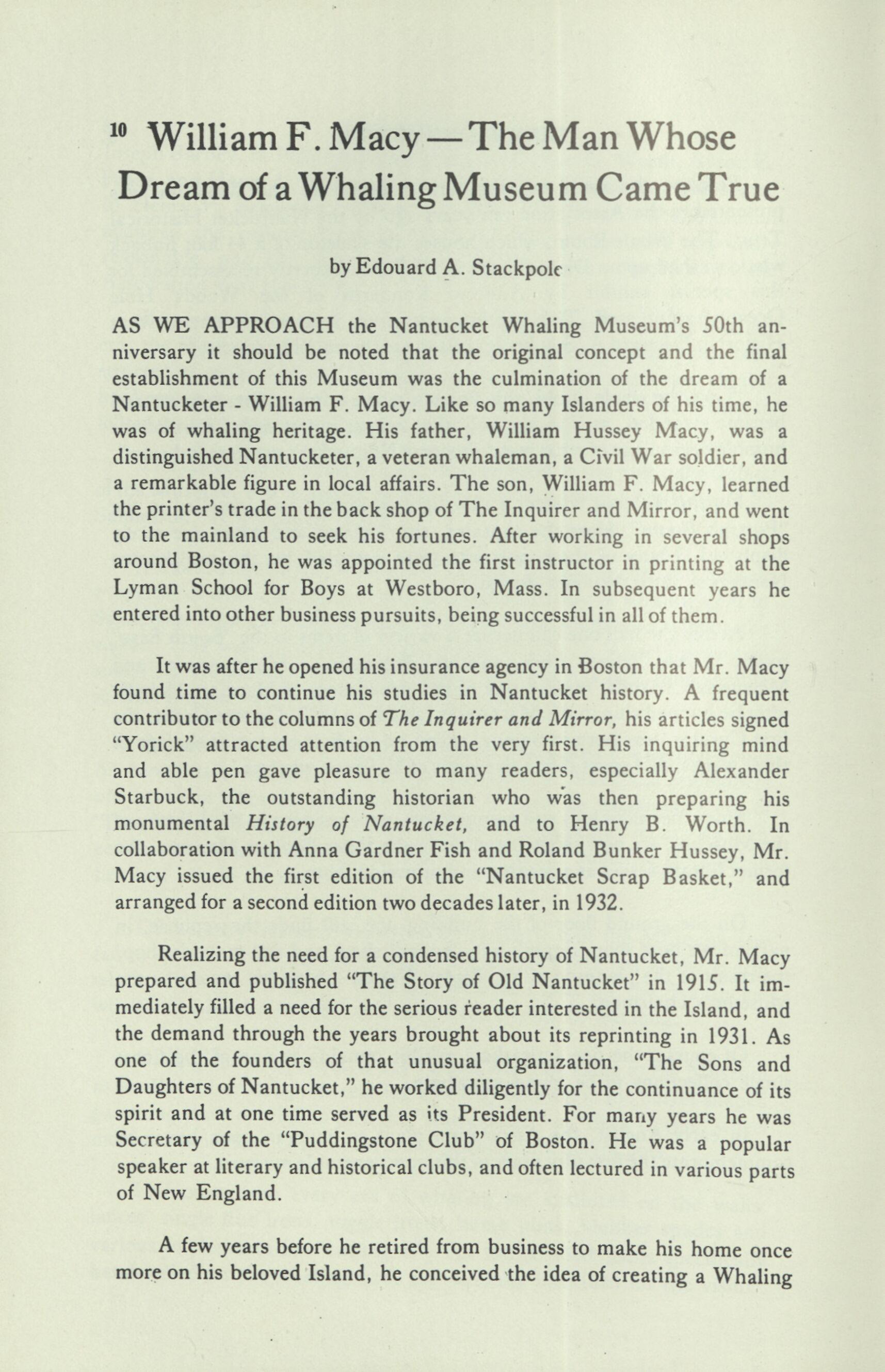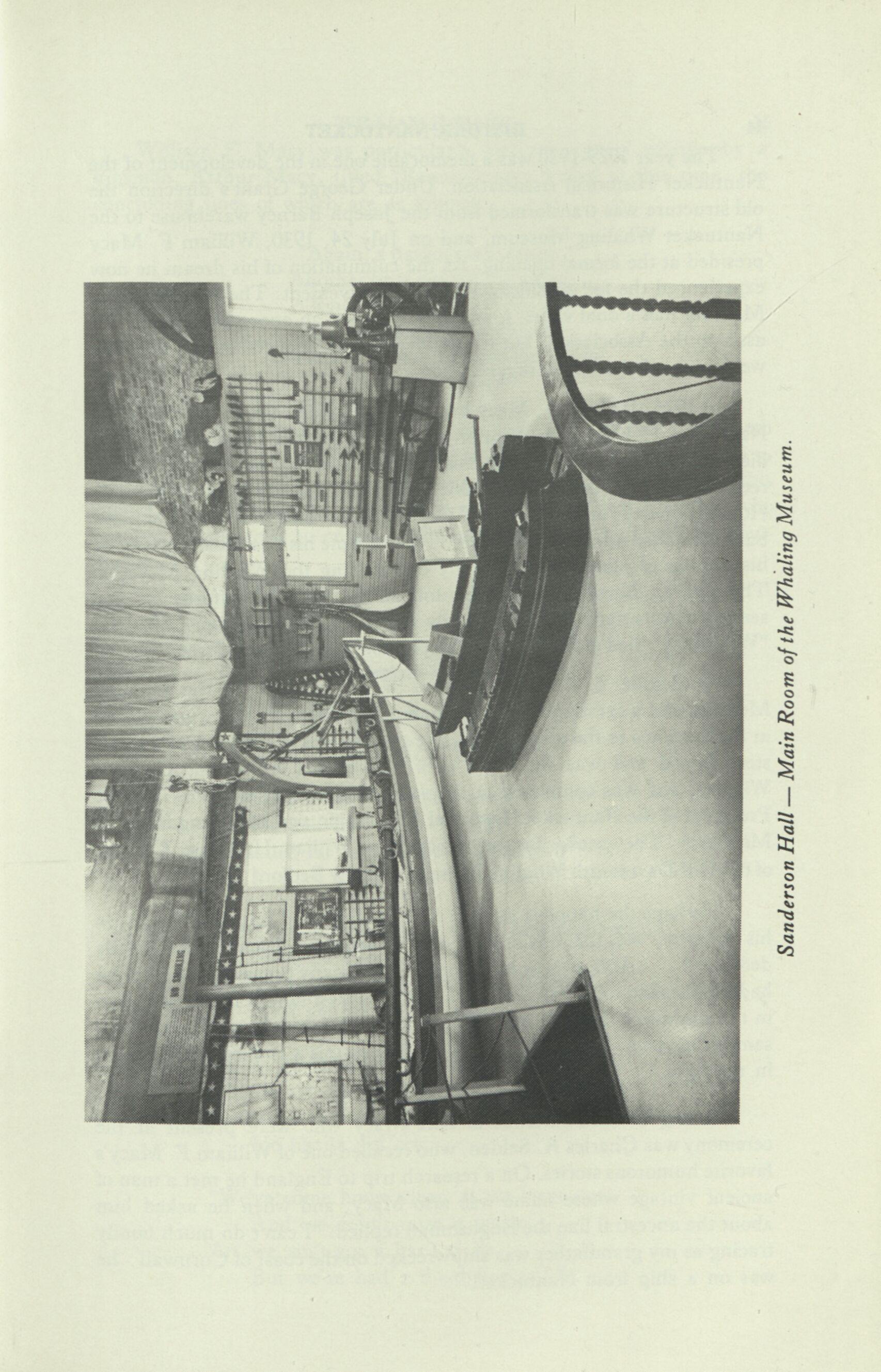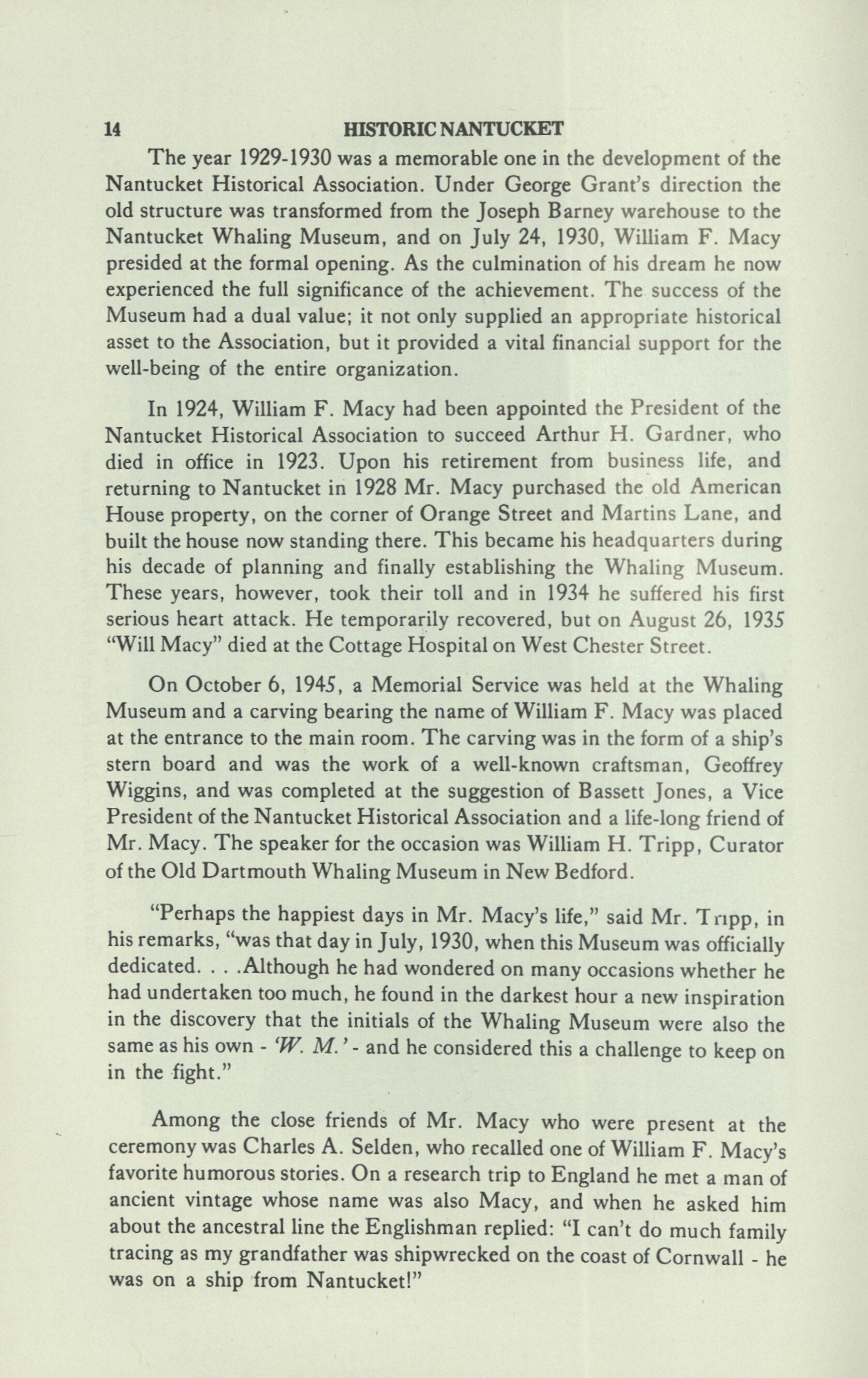
6 minute read
by Edouard A. Stackpole
10 William F. Macy — The Man Whose Dream of a Whaling Museum Came True
by Edouard A. Stackpole
AS WE APPROACH the Nantucket Whaling Museum's 50th anniversary it should be noted that the original concept and the final establishment of this Museum was the culmination of the dream of a Nantucketer - William F. Macy. Like so many Islanders of his time, he was of whaling heritage. His father, William Hussey Macy, was a distinguished Nantucketer, a veteran whaleman, a Civil War soldier, and a remarkable figure in local affairs. The son, William F. Macy, learned the printer's trade in the back shop of The Inquirer and Mirror, and went to the mainland to seek his fortunes. After working in several shops around Boston, he was appointed the first instructor in printing at the Lyman School for Boys at Westboro, Mass. In subsequent years he entered into other business pursuits, being successful in all of them.
It was after he opened his insurance agency in Boston that Mr. Macy found time to continue his studies in Nantucket history. A frequent contributor to the columns of The Inquirer and Mirror, his articles signed "Yorick" attracted attention from the very first. His inquiring mind and able pen gave pleasure to many readers, especially Alexander Starbuck, the outstanding historian who was then preparing his monumental History of Nantucket, and to Henry B. Worth. In collaboration with Anna Gardner Fish and Roland Bunker Hussey, Mr. Macy issued the first edition of the "Nantucket Scrap Basket," and arranged for a second edition two decades later, in 1932.
Realizing the need for a condensed history of Nantucket, Mr. Macy prepared and published "The Story of Old Nantucket" in 1915. It immediately filled a need for the serious reader interested in the Island, and the demand through the years brought about its reprinting in 1931. As one of the founders of that unusual organization, "The Sons and Daughters of Nantucket," he worked diligently for the continuance of its spirit and at one time served as its President. For many years he was Secretary of the "Puddingstone Club" of Boston. He was a popular speaker at literary and historical clubs, and often lectured in various parts of New England.
A few years before he retired from business to make his home once more on his beloved Island, he conceived the idea of creating a Whaling
William F. Macy — The Man Whose Dream Came True Born July 17, 1867 - Died August 27, 1935

12 HISTORIC NANTUCKET
• Museum on Nantucket. Commencing his "campaign" (as he termed it) for public support, Mr. Macy called attention to the fact that Nantucket was the literal founder of the American deep-sea whaling industry. He appealed to all who were descendants of Nantucket, living on the mainland, to prominent summer residents, to foundations, of all kinds, and to Nantucketers themselves for support in his drive for funds.
Fortunately, there was a summer resident of Nantucket at that time who had laid the ground work for Mr. Macy's proposal, and to whom Mr. Macy became a close friend. This man was Edward F. Sanderson, who had been collecting whaling gear and material for a number of years. Mr. Sanderson had purchased the brick mansion on Pleasant Street known as Moors' End, and became an enthusiastic collector of whaling material. His intimate friend, Henry Schauffler, had acquired the old Hadwen & Barney Candle House at the head of Steamboa. "T'harf. It was in this structure that Mr. Sanderson placed much of his collections of whaling gear, including much material he had purchased in England.
Knowing that this was an ideal time to launch his campaign, William F. Macy, in 1927-28, increased his appeals for the creation of a Nantucket Whaling Museum. Back in the 19th century his father, William Hussey Macy, had written "Thar She Blows!" - an Island classic on whaling - and with this as an inspiration, his son became a challenging figure, redoubling his efforts, giving every moment he could to his campaign. Mr. Sanderson, lending his support, encouraged all Mr. Macy's efforts. At last, the Carnegie Foundation in response to an inspired appeal, gave $10,000 to the cause, and in 1929 Mr. Macy triumphantly announced that the long struggle for funds had been successfully completed. The Sanderson collection had been promised and the old Candle House could be obtained for the creation of Nantucket's Whaling Museum. Deeds were passed for the conveyance of the structure to the Association in August 1929.

Mr. Macy made prompt acknowledgement to his friends and supporters in 1931, when he wrote:
"A warm tribute was paid Mr. Edward F. Sanderson for the generous gift of his great collections, his foresight in receiving and holding the Old Candle House for us, and the liberal terms granted us on its purchase. . . .To his friend, the late Henry P. Schauffler, one of our former vice-presidents, and the man who actually started the movement for this Museum, we also owe a great debt, which we are glad to acknowledge at this time."

14 HISTORIC NANTUCKET
The year 1929-1930 was a memorable one in the development of the Nantucket Historical Association. Under George Grant's direction the old structure was transformed from the Joseph Barney warehouse to the Nantucket Whaling Museum, and on July 24, 1930, William F. Macy presided at the formal opening. As the culmination of his dream he now experienced the full significance of the achievement. The success of the Museum had a dual value; it not only supplied an appropriate historical asset to the Association, but it provided a vital financial support for the well-being of the entire organization.
In 1924, William F. Macy had been appointed the President of the Nantucket Historical Association to succeed Arthur H. Gardner, who died in office in 1923. Upon his retirement from business life, and returning to Nantucket in 1928 Mr. Macy purchased the old American House property, on the corner of Orange Street and Martins Lane, and built the house now standing there. This became his headquarters during his decade of planning and finally establishing the Whaling Museum. These years, however, took their toll and in 1934 he suffered his first serious heart attack. He temporarily recovered, but on August 26, 1935 "Will Macy" died at the Cottage Hospital on West Chester Street.
On October 6, 1945, a Memorial Service was held at the Whaling Museum and a carving bearing the name of William F. Macy was placed at the entrance to the main room. The carving was in the form of a ship's stern board and was the work of a well-known craftsman, Geoffrey Wiggins, and was completed at the suggestion of Bassett Jones, a Vice President of the Nantucket Historical Association and a life-long friend of Mr. Macy. The speaker for the occasion was William H. Tripp, Curator of the Old Dartmouth Whaling Museum in New Bedford.

"Perhaps the happiest days in Mr. Macy's life," said Mr. Tripp, in his remarks, "was that day in July, 1930, when this Museum was officially dedicated. . . .Although he had wondered on many occasions whether he had undertaken too much, he found in the darkest hour a new inspiration in the discovery that the initials of the Whaling Museum were also the same as his own - W. M.' - and he considered this a challenge to keep on in the fight."
Among the close friends of Mr. Macy who were present at the ceremony was Charles A. Selden, who recalled one of William F. Macy's favorite humorous stories. On a research trip to England he met a man of ancient vintage whose name was also Macy, and when he asked him about the ancestral line the Englishman replied: "I can't do much family tracing as my grandfather was shipwrecked on the coast of Cornwall - he was on a ship from Nantucket!"









